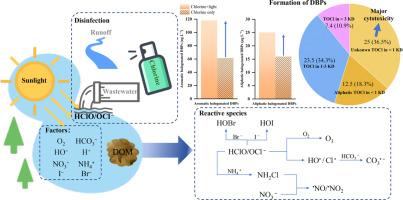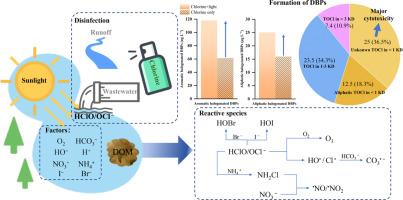Generation of DBPs from dissolved organic matter by solar photolysis of chlorine: Associated changes of cytotoxicity and reactive species
IF 12.4
1区 环境科学与生态学
Q1 ENGINEERING, ENVIRONMENTAL
引用次数: 0
Abstract
Since elevated amounts of chlorine disinfectant were discharged into surface water, more attention should be paid to the reactions between dissolved organic matter (DOM) and chlorine under sunlight. However, disinfection byproducts (DBPs) formed from DOM by solar photolysis of chlorine, and changes of cytotoxicity during this process remain unclear. In this study, it was found that solar photolysis of chlorine significantly promoted the formation of aliphatic chlorinated DBPs and aromatic chlorinated DBPs (including chlorobenzoquinone) by 44.7–109 % and 81.7–121 %, respectively compared with dark chlorination. Unknown total organic chlorine contained in low molecular weight fraction (<1 kD) significantly positively correlated to the cytotoxicity of water samples. Several factors (bicarbonate, dissolved oxygen, pH, nitrate, ammonia, bromide, and iodide) affecting the radical chemistry, and the formation of DBPs under solar photolysis of chlorine were also investigated. Reactive species including HO•, Cl•, O3, and reactive nitrogen species (RNS) were responsible for forming different DBPs. Especially O3 increased the formation of most categories of DBPs tested in this study, and RNS contributed to the formation of nitrogenous DBPs. This study provided more understanding of the adverse impact of overused chlorine, and reaction mechanisms between reactive species and DOM.


氯光解作用下溶解有机物生成DBPs:细胞毒性和活性物质的相关变化
由于含氯消毒剂排入地表水的量增加,在阳光照射下,溶解有机物(DOM)与氯的反应应引起更多关注。然而,DOM在太阳能光解氯作用下产生的消毒副产物(DBPs)及其在此过程中的细胞毒性变化尚不清楚。本研究发现,与暗氯化相比,氯光解能显著促进脂肪族氯化DBPs和芳香族氯化DBPs(含氯苯醌)的形成,分别提高44.7% - 109%和81.7-121%。低分子量分数(<;1kD)与水样细胞毒性呈显著正相关。研究了碳酸氢盐、溶解氧、pH、硝酸盐、氨、溴化物和碘化物等因素对自由基化学的影响,以及氯光解作用下DBPs的形成。HO•、Cl•、O3和活性氮(RNS)是形成不同dbp的活性物质。特别是O3增加了本研究中测试的大多数dbp的形成,RNS有助于氮dbp的形成。本研究进一步了解了氯过量使用的不良影响,以及活性物质与DOM之间的反应机理。
本文章由计算机程序翻译,如有差异,请以英文原文为准。
求助全文
约1分钟内获得全文
求助全文
来源期刊

Water Research
环境科学-工程:环境
CiteScore
20.80
自引率
9.40%
发文量
1307
审稿时长
38 days
期刊介绍:
Water Research, along with its open access companion journal Water Research X, serves as a platform for publishing original research papers covering various aspects of the science and technology related to the anthropogenic water cycle, water quality, and its management worldwide. The audience targeted by the journal comprises biologists, chemical engineers, chemists, civil engineers, environmental engineers, limnologists, and microbiologists. The scope of the journal include:
•Treatment processes for water and wastewaters (municipal, agricultural, industrial, and on-site treatment), including resource recovery and residuals management;
•Urban hydrology including sewer systems, stormwater management, and green infrastructure;
•Drinking water treatment and distribution;
•Potable and non-potable water reuse;
•Sanitation, public health, and risk assessment;
•Anaerobic digestion, solid and hazardous waste management, including source characterization and the effects and control of leachates and gaseous emissions;
•Contaminants (chemical, microbial, anthropogenic particles such as nanoparticles or microplastics) and related water quality sensing, monitoring, fate, and assessment;
•Anthropogenic impacts on inland, tidal, coastal and urban waters, focusing on surface and ground waters, and point and non-point sources of pollution;
•Environmental restoration, linked to surface water, groundwater and groundwater remediation;
•Analysis of the interfaces between sediments and water, and between water and atmosphere, focusing specifically on anthropogenic impacts;
•Mathematical modelling, systems analysis, machine learning, and beneficial use of big data related to the anthropogenic water cycle;
•Socio-economic, policy, and regulations studies.
 求助内容:
求助内容: 应助结果提醒方式:
应助结果提醒方式:


